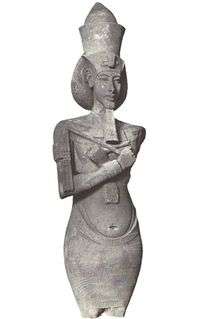Pharaoh's Unusual Feminine Appearance Suggests Two Gene Defects

The feminine features and elongated head of ancient Egypt’s King Akhenaten may be attributed to two genetic defects called aromatose excess syndrome and craniosynostosis, said Yale School of Medicine dermatology professor Irwin Braverman, M.D.
Because no mummy of Akhenaten exists, Braverman used only artwork of the ancient pharaoh to make his medical diagnosis. He presented his theories during the 14th annual Historical Clinicopathological Conference (CPC) at University of Maryland Medical School.
Akhenaten, a pharaoh during Egypt’s 18th Dynasty credited with starting the practice of worshipping one God, fathered six children. He was often portrayed in sculptures and carvings with a thin neck, elongated head, large buttocks, breasts, and even a prominent belly, suggesting pregnancy.
It may be possible to confirm his diagnoses, Braverman said, by conducting genetic tests on the five relevant mummies of Akhenaten’s relatives. “DNA taken from the bone marrow could reveal the presence of the gene defects,” he said.
Aromatose excess syndrome can lead to feminine features in men and advanced sexual development in girls. Akhenaten’s daughters are depicted with breasts at age three and seven in some carvings.
Braverman explains that Akhenaten’s elongated head could be due to the gene defect causing craniosynostosis, in which the fibrous joints of the head fuse at an early age and disrupt the process of skull formation. Braverman said that a number of Akhenaten’s relatives—including his daughters, and two other 18th-Dynasty rulers, Queen Hatshepsut and King Tut—all had cranial abnormalities that mimicked craniosynostosis.
Akhenaten’s feminine physical attributes have yet to be fully explained, but Braverman urges Egyptologists to explore his theory.
In 1997, Braverman developed a class, that is now required at Yale and over a dozen medical schools, to help medical students sharpen their observational skills. The students observe highly detailed works of art at a museum and then describe what they saw. This technique has been shown to improve observational skills for patient diagnosis.
Source: Yale University





















